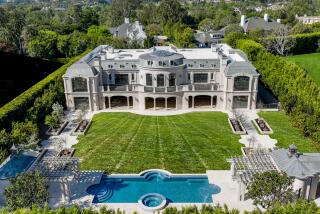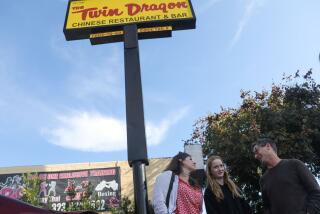Armenian Americans Honor Two Christmases
Jews are well familiar with the so-called “December dilemma” of getting through the Christmas season with its ubiquitous carols, advertising and holiday displays. One answer has been to lift the relatively minor Jewish festival of Hanukkah into competition with the major Christian observance of Christmas.
Armenian Orthodox Christians in the United States face their own December dilemma.
For the overwhelming majority of Christian denominations, the Christmas holiday culminates with celebrations Dec. 24 and 25. But Armenian churches wait until Jan. 6.
The observance of what has come to be called Armenian Christmas underscores an almost 1,700-year divide between the Armenian church and most other churches over when to mark the birth of Jesus.
The two Southern California-based Armenian archbishops this week sought to bridge the differences, honoring their own calendar and traditions while acknowledging that many of their members participate in Dec. 25 festivities.
That stance reflects the reality of a distinct ethnic church ministering in a religiously and culturally diverse region and nation. By contrast, in Armenia, there was little alternative to the Armenian church and its Jan. 6 observance of Christ’s birth.
But among Armenians in America, holiday dinners and family reunions are common on Dec. 25 and during New Year’s gift exchanges, as well as on Jan. 6. Tables are spread with fish, rice pilaf and spinach; kebabs of beef, lamb and chicken; and kufte, a ground meat wrapped in a fried bulgur wheat shell. Presents are sometimes wrapped in the colors of the Armenian flag: red, blue and orange.
There are an estimated 500,000 to 700,000 Armenians in California.
“I cannot possibly tell my people you are not part of this tradition,” said Hovnan Derderian, primate of the Western Diocese of the Armenian Church of North America.
“If Dec. 25 is conveying the good news about Jesus’ birth, there is every reason for us to take it as a blessing, because in today’s society the more venues we look for to celebrate Christianity in our life, the better for our communities,” said Derderian, a native of Beirut.
The other Southern California Armenian prelate agreed that it is fine to celebrate both dates.
“We cannot deny that they do” also mark Dec. 25, said Archbishop Moushegh Mardirossian, prelate of the Western Prelacy of the Armenian Apostolic Church of America, which is administratively separate from Derderian’s overlapping Western Diocese. “They bring me gifts too.”
“I don’t think our churches should emphasize the differences between the dates we are celebrating,” Mardirossian said.
In fact, no one knows exactly when Jesus was born. Nor is his birth believed to have been celebrated in the earliest days of the church. According to the Armenian church, all Christian churches used to celebrate Christ’s birth on Jan. 6. But in the year 325, the Roman emperor Constantine decreed that it would be celebrated in his empire on Dec. 25.
There are various reasons given for Constantine’s edict. But one oft-repeated account suggests that it was a move by the church in Rome to usurp a popular pagan holiday celebrating “the invincible or unconquered sun god” with a Christian observance of the birth of the son of God.
By the end of the 4th century, the Greek-speaking Christian world had also adopted Dec. 25, including what is today’s Greek Orthodox Church. But the Armenian church held its ground. Jan. 6 endured as a date to mark both the birth and baptism of Jesus. For some orthodox churches, including the Russian Orthodox Church, Christmas is celebrated Jan. 7.
The Western church adopted Jan. 6 as the Epiphany, the time when Jesus was adored by the wise men. In the Armenian church, however, several themes are woven into the Jan. 6 observance, including Jesus’ birth, baptism and the “manifestation,” or epiphany, of Jesus as the son of God.
Derderian said Armenian Christians found no reason to change the date to Dec. 25 because in Armenia, pagan observances did not encroach on Jan. 6.
“It had nothing to do with Armenian life,” he said. Of course, he said, the Armenian church was not above stamping out pagan vestiges it did find, such as building churches on the foundations of ancient pagan temples.
The two Southern California archbishops are in agreement on their views of Christmas and other liturgical and doctrinal matters. However, they represent two distinct administrative branches of what they insist is one Armenian church.
The two wings, headed by separate catholicos, or popes, arose in large part from the rise and fall of the former Soviet Union, of which Armenia was a part. As religious freedom was restricted, some Armenian Apostolic churches abroad switched allegiance to the Lebanon-based See of Cilicia. Mardirossian answers to that wing.
Derderian is part of the older church, headquartered in the Armenian city of Echmiadzin. There have been attempts to reunify the two wings, and there has been cooperation. But there is no immediate prospect of a return to a single hierarchy.
Still, they sounded similar themes about Western and Armenian Christmases. Derderian said he would preside over Christmas observances Jan. 6 that would be decidedly ecumenical in character.
“We should never allow ourselves to become islands in the community of Christian churches,” he said.
For example, one of his ecumenical guests, the Very Rev. John Bakas, dean of the Greek Orthodox St. Sophia Cathedral in Los Angeles, has been invited to deliver the homily.
The service, known as the Feast of the Nativity and Theophany of Our Lord Jesus Christ, will be held at 11 a.m. Friday at St. John Garabed Armenian Church, 1201 N. Vine St., Hollywood.
Derderian’s diocese includes 47 parishes in California, Arizona, Colorado, Hawaii, Nevada, New Mexico, Oregon, Utah, Washington and Mexico.
In his Christmas message, Derderian said, he will urge the faithful to “enrich your new life with new commitments and dedication, making the service of God the path of your lives.”
In separate services, Archbishop Mardirossian will celebrate the Divine Liturgy at 5 p.m. Thursday at St. Sarkis Armenian Apostolic Church, 58 S. Sierra Madre Blvd., Pasadena. At 10:30 a.m. Friday he will again celebrate Divine Liturgy at St. Mary’s Armenian Apostolic Church, 500 Central Ave., Glendale. Immediately following will be the observance of Jesus’ baptism, in which a cross is placed in water and sacramental oil, known as Holy Muron, is poured in as a sign of the descent of the Holy Spirit upon Jesus.
Mardirossian said he will speak of the angels who proclaimed Jesus’ birth.
“The Christmas season is a season for renewal in our faith, and to live with joy and harmony with each other, and in peace, as the angels sang,” he said.
In practical terms, he said, that means glorifying God-given lives by love and service to others.
More to Read
Sign up for Essential California
The most important California stories and recommendations in your inbox every morning.
You may occasionally receive promotional content from the Los Angeles Times.










